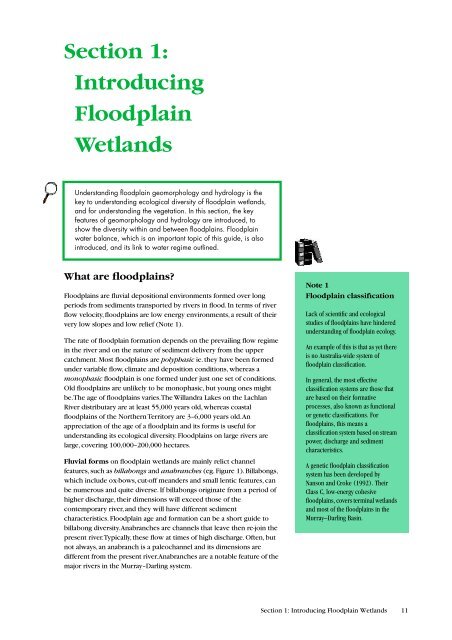Estimating the Water Requirements for Plants of Floodplain Wetlands
Estimating the Water Requirements for Plants of Floodplain Wetlands
Estimating the Water Requirements for Plants of Floodplain Wetlands
You also want an ePaper? Increase the reach of your titles
YUMPU automatically turns print PDFs into web optimized ePapers that Google loves.
Section 1:Introducing<strong>Floodplain</strong><strong>Wetlands</strong>Understanding floodplain geomorphology and hydrology is <strong>the</strong>key to understanding ecological diversity <strong>of</strong> floodplain wetlands,and <strong>for</strong> understanding <strong>the</strong> vegetation. In this section, <strong>the</strong> keyfeatures <strong>of</strong> geomorphology and hydrology are introduced, toshow <strong>the</strong> diversity within and between floodplains. <strong>Floodplain</strong>water balance, which is an important topic <strong>of</strong> this guide, is alsointroduced, and its link to water regime outlined.What are floodplains?<strong>Floodplain</strong>s are fluvial depositional environments <strong>for</strong>med over longperiods from sediments transported by rivers in flood. In terms <strong>of</strong> riverflow velocity, floodplains are low energy environments, a result <strong>of</strong> <strong>the</strong>irvery low slopes and low relief (Note 1).The rate <strong>of</strong> floodplain <strong>for</strong>mation depends on <strong>the</strong> prevailing flow regimein <strong>the</strong> river and on <strong>the</strong> nature <strong>of</strong> sediment delivery from <strong>the</strong> uppercatchment. Most floodplains are polyphasic ie. <strong>the</strong>y have been <strong>for</strong>medunder variable flow, climate and deposition conditions, whereas amonophasic floodplain is one <strong>for</strong>med under just one set <strong>of</strong> conditions.Old floodplains are unlikely to be monophasic, but young ones mightbe. The age <strong>of</strong> floodplains varies. The Willandra Lakes on <strong>the</strong> LachlanRiver distributary are at least 55,000 years old, whereas coastalfloodplains <strong>of</strong> <strong>the</strong> Nor<strong>the</strong>rn Territory are 3–6,000 years old. Anappreciation <strong>of</strong> <strong>the</strong> age <strong>of</strong> a floodplain and its <strong>for</strong>ms is useful <strong>for</strong>understanding its ecological diversity. <strong>Floodplain</strong>s on large rivers arelarge, covering 100,000–200,000 hectares.Fluvial <strong>for</strong>ms on floodplain wetlands are mainly relict channelfeatures, such as billabongs and anabranches (eg. Figure 1). Billabongs,which include ox-bows, cut-<strong>of</strong>f meanders and small lentic features, canbe numerous and quite diverse. If billabongs originate from a period <strong>of</strong>higher discharge, <strong>the</strong>ir dimensions will exceed those <strong>of</strong> <strong>the</strong>contemporary river, and <strong>the</strong>y will have different sedimentcharacteristics. <strong>Floodplain</strong> age and <strong>for</strong>mation can be a short guide tobillabong diversity. Anabranches are channels that leave <strong>the</strong>n re-join <strong>the</strong>present river. Typically, <strong>the</strong>se flow at times <strong>of</strong> high discharge. Often, butnot always, an anabranch is a paleochannel and its dimensions aredifferent from <strong>the</strong> present river. Anabranches are a notable feature <strong>of</strong> <strong>the</strong>major rivers in <strong>the</strong> Murray–Darling system.Note 1<strong>Floodplain</strong> classificationLack <strong>of</strong> scientific and ecologicalstudies <strong>of</strong> floodplains have hinderedunderstanding <strong>of</strong> floodplain ecology.An example <strong>of</strong> this is that as yet <strong>the</strong>reis no Australia-wide system <strong>of</strong>floodplain classification.In general, <strong>the</strong> most effectiveclassification systems are those thatare based on <strong>the</strong>ir <strong>for</strong>mativeprocesses, also known as functionalor genetic classifications. Forfloodplains, this means aclassification system based on streampower, discharge and sedimentcharacteristics.A genetic floodplain classificationsystem has been developed byNanson and Croke (1992). TheirClass C, low-energy cohesivefloodplains, covers terminal wetlandsand most <strong>of</strong> <strong>the</strong> floodplains in <strong>the</strong>Murray–Darling Basin.Section 1: Introducing <strong>Floodplain</strong> <strong>Wetlands</strong> 11
















